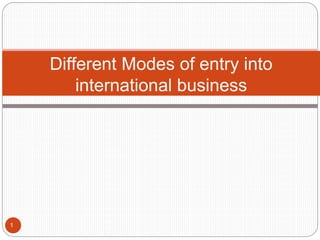
modes of entry.pptx
- 1. Different Modes of entry into international business 1
- 2. Different modes of entry ⚫ Exporting ⚫ Licensing ⚫ Franchising ⚫ Contract manufacturing ⚫ Management Contracts ⚫ FDI without alliances ⚫ FDI with alliances 2
- 3. Forms of Exporting 1 • Indirect Exporting 2 • Direct Exporting 3 • Intra-corporate Transfers 3
- 4. Forms of Exporting ⚫Exporting means shipping the goods and services out of the port of a country. Seller is referred to as an "exporter" . Buyer is referred to as an "importer“. ⚫Indirect Exporting means that the firm participates in international business through an intermediary and does not deal with foreign customers or markets. ⚫Direct exporting means that the firm works with foreign customers or markets with the opportunity to develop a relationship. 4
- 6. Indirect Exporting – Eg. ⚫Exporting of goods and services through various home-based exporters ⚫Manufacturers’ export agents ⚫Export commission agents ⚫Export merchants ⚫International firms 6
- 9. Exporting Advantages Relatively low financial exposure Permit gradual market entry Acquire knowledge about local market Avoid restrictions on foreign investment Disadvantages Vulnerability to tariffs and NTBs Logistical complexities Potential conflicts with distributors 9
- 10. Licensing 10 ⚫Licensing is when a firm, called the licensor, leases the right to use its intellectual property—technology, work methods, patents, copyrights, brand names, or trademarks—to another firm, called the licensee, in return for a fee. ⚫The property licensed may include: ⚫Patents ⚫Trademarks ⚫Copyrights ⚫Technology ⚫Technical know-how ⚫Specific business skills
- 12. Basic Issues in International Licensing ⚫Specifying the boundaries of the agreement ⚫Determining compensation ⚫Establishing rights, privileges, and constraints ⚫Specifying the duration of the contract ⚫Differences in laws and culture. Eg. Pepsico, Coke Bottling Plant 12
- 13. Licensing –Adv. & Disadv. • Low financial risks • Low-cost way to assess market potential • Avoid tariffs restrictions on foreign investment • Licensee provides knowledge of local markets Advantages Disadvantages • Limited market opportunities/profits • Dependence on licensee • Potential conflicts with licensee • Possibility of creating future competitor 13
- 14. ⚫Under franchising, an independent organization called the franchisee operates the business under the name of another company called the franchisor. ⚫In such an arrangement the franchisee pays a fee to the franchisor. ⚫Franchising is a form of Licensing but the Franchisor can exercise more control over the Franchisee as compared to that in Licensing. Franchising 14
- 15. Franchising Agreements ⚫Franchisee has to pay a fixed amount and royalty based on sales. ⚫Franchisee should agree to adhere to follow the franchisor’s requirements ⚫Franchisor helps the franchisee in establishing the manufacturing facilities ⚫Franchisor allows the franchisee some degree of flexibility. ⚫Eg. McDonalds, Subway, KFC 15
- 16. Franchising- Adv. & Disadvantages Advantages Disadvantages ⚫ Low financial risks ⚫ Low-cost way to assess market potential ⚫ Avoid tariffs, restrictions on foreign investment ⚫ Maintain more control than with licensing ⚫ Franchisee provides knowledge of local market 16 ⚫ Limited market opportunities/profits ⚫ Dependence on franchisee ⚫ Potential conflicts with franchisee ⚫ Possibility of creating future competitor
- 17. FDI without alliances Companies enter the international market through FDI , invest their money, establish manufacturing and marketing facilities through ownership and control. Greenfield strategy- the term Greenfield refers to starting of the operations of a company from scratch in a foreign market. 17
- 18. Greenfield Strategy • Best site • Modern facilities • Economic development incentives • Clean slate Advantages • Huge time and patience needed • Expensive • Comply with local and national regulation • Local workforce needed • Strongly perceived as a foreign worker Disadvantages 19
- 19. FDI with strategic alliances Strategic alliance is a cooperative and collaborative approach to achieve the larger goals. Role of alliances ⚫ Many complicated issues are solved through alliances ⚫ They provide the parties each other’s strengths ⚫ Helps in developing new products with the interaction of 2 or more industries ⚫ Meet the challenges of technological revolution. ⚫ Managing heavy outlay ⚫ Become strong to compete with a multinational company. 20
- 20. FDI with strategic alliances Modes of FDI through alliances are: ⚫Merger : The combining of two or more companies, generally by offering the stockholders of one company securities in the acquiring company in exchange for the surrender of their stock. ⚫Acquisition : When one company takes over another and clearly established itself as the new owner, the purchase is called an acquisition. ⚫Joint ventures is an entity formed between two or more parties to undertake economic activity together. The parties agree to create a new entity by both contributing equity, and then they share in the revenues, expenses, and control of the enterprise. 21
- 21. Examples Merger Acquisition ⚫ING Vysya merged into Kotak Mahindra ⚫Ranbaxy into Sun Pharma ⚫Tata Chemicals took over British salt based in UK 21 ⚫Flipkart acquired Myntra ⚫Yahoo acquired Bookpad ⚫Asian paints acquired front end sales of Ess Ess bathroom Products ⚫ICICI Bank's acquisition of Bank of Rajas
- 22. Acquisition Advantages Disadvantages ⚫ Obtains control over the acquired firm such as factories and brand names ⚫ Integrate the mgt of the firm into its overall international strategy 22 ⚫Assumes all the liabilities such as financial and managerial
- 23. Joint Ventures Advantages Disadvantages ⚫Benefit from local partner’s knowledge. ⚫Shared costs/risks with partner. ⚫Reduced political risk. 23 ⚫Risk giving control of technology to partner. ⚫May not realize experience curve or location economies. ⚫Shared ownership can lead to conflict